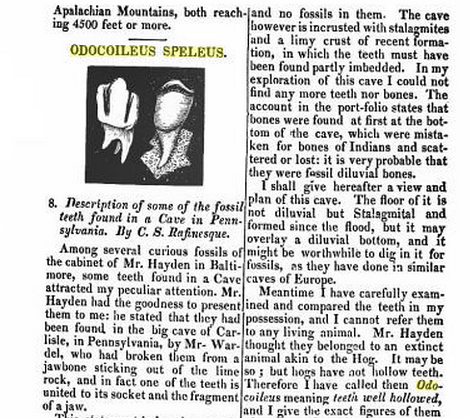Earlier this year my friend John Acorn was frustrated by the genus name for white-tailed and mule deer: Odocoileus. Greek and Latin dictionaries didn’t help to make sense of it, no matter how potential roots were parsed. He enlisted me and Selina Stewart, a professor of classics at the University of Alberta, in the hunt for the origin of this name. It was an exciting few hours of Googling! Many emails were exchanged as we followed blind leads, downloaded uninformative pdfs, and speculated wildly. Then, by chance, I thought to look up where the description of the type species of Odocoileus was published, with the hope that the author of the genus had actually explained his rationale for choosing the name. To my surprise, neither O. virginianus nor O. hemionus – the only two extant members of the genus – turned out to be the type species. Instead, it was a deer I’d never heard of: Odocoileus speleus. A cave-dwelling deer? What could this mean? The author was C.S. Rafinesque, and the description was published in The Atlantic Journal, and Friend of Knowledge, Vol. 1, in 1832.
Rafinesque lived from 1783-1840 and had quite a diverse career, dabbling in zoology, botany, geology and Mesoamerican linguistics. He named many species of plants and animals in addition to cervids. Wikipedia calls Rafinesque a polymath, but he didn’t excel in all endeavours. For one thing, his stint as the botanist at Transylvania University in Kentucky ended badly after he had an affair with the wife of the university’s president. For another, he was quite careless with his spelling. This explains Odocoileus. The genus is based on a fossil (or possibly subfossil) tooth found in a cave – hence speleus. Rafinesque had intended the generic name of the tooth’s owner, which he thought might be a type of pig, to refer to the tooth’s hollowness (see excerpt below). But rather than Odontocoelus, which would have matched his intent well, he wrote the jumbled name that still stands today. There were two attempts at the beginning of the 1900’s to emend the spelling to something more etymologically, but these were deemed unjustified.
That spelling was a persistent challenge for Rafinesque is evidenced by his naming a population of white-tailed deer Corvus macrourus.


I love it! That’s quite the typo.
It is indeed! One wonders if Rafinesque suffered from dyslexia.
Where did you find the image for the deer skull? I am a researcher interested in its antler morphology but couldn’t find images of that UNAM collection on-line despite finding their website.
Hi Erin:
I took the photo myself of a specimen at the UNAM collection at the Chamela field station, not at the main UNAM collection in Mexico City. Enrique Ramirez Garcia is the curator who helped me with access to the collections there; perhaps you could ask him about the deer skulls there (for his email see http://www.ibiologia.unam.mx/ebchamela/www/academicos.htm).